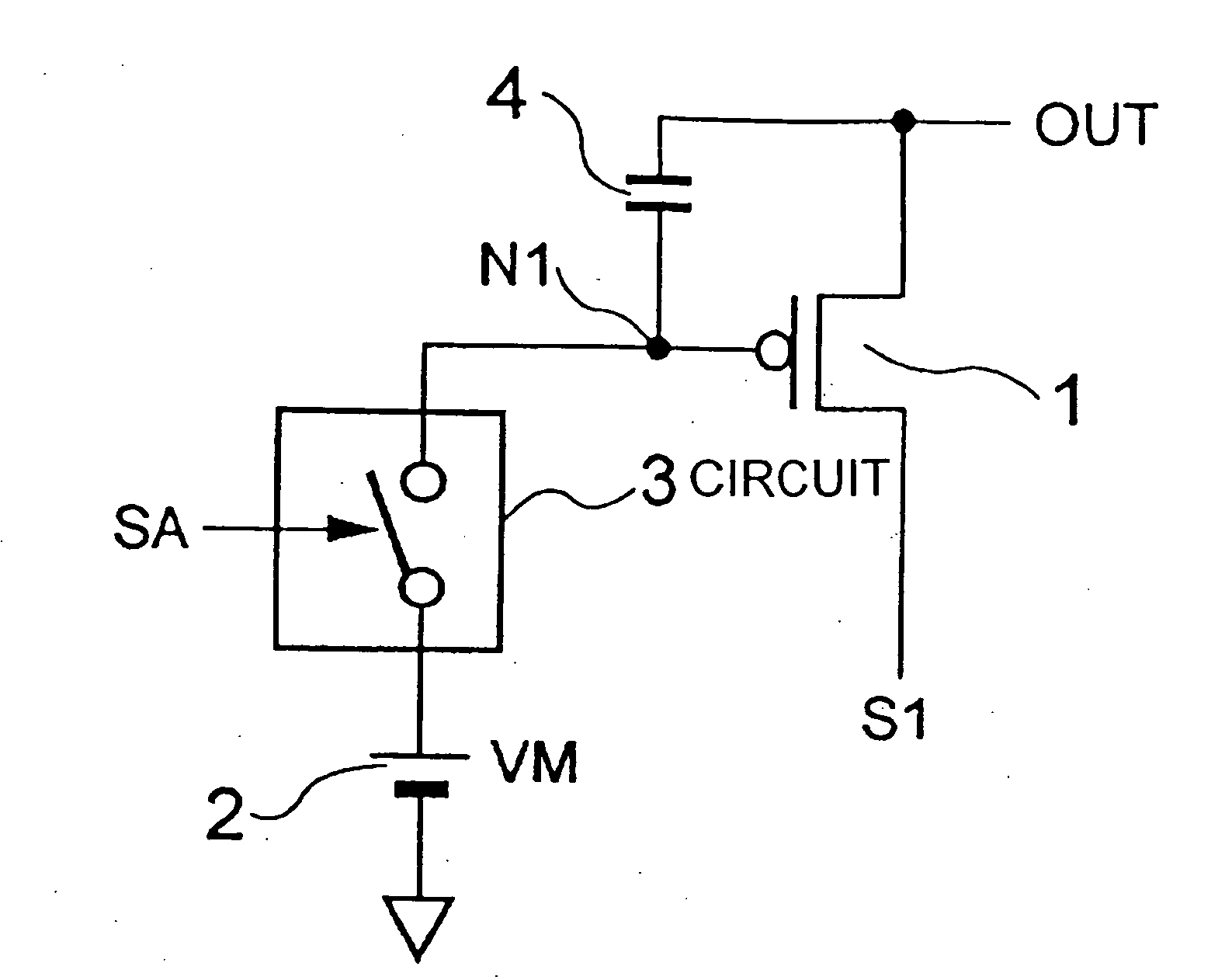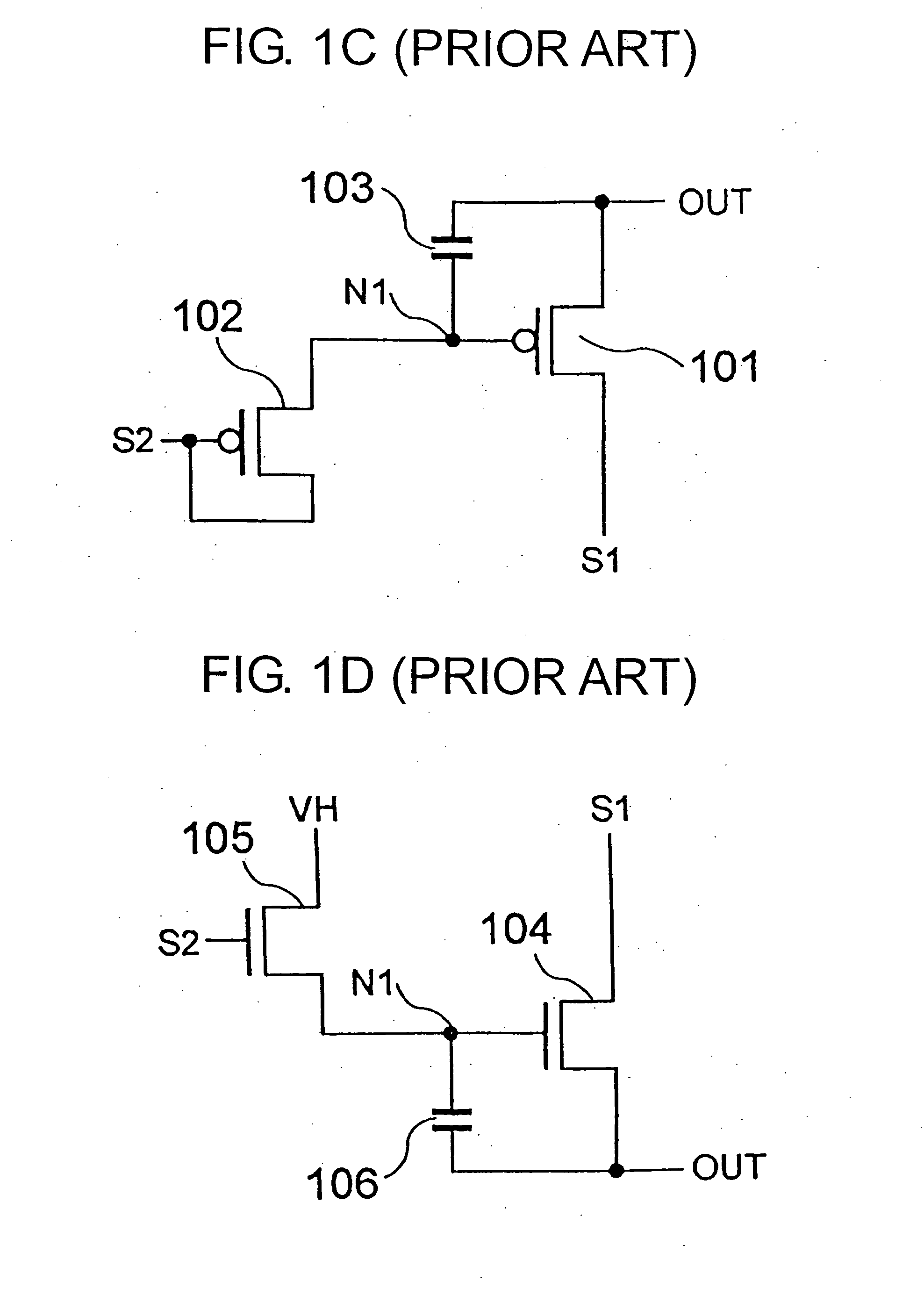Bootstrap circuit and driving method thereof
- Summary
- Abstract
- Description
- Claims
- Application Information
AI Technical Summary
Benefits of technology
Problems solved by technology
Method used
Image
Examples
first embodiment
1. First Embodiment
[0067] Referring to FIG. 2, a bootstrap circuit according to a first embodiment of the present invention includes a P-channel MOS (PMOS) transistor 1 that outputs pulses, a coupling capacitor 4 connected between the source electrode (output OUT) and gate electrode (node N1) of the transistor 1, a power source 2 that outputs a DC voltage VM, and a circuit 3 for controllably applying the potential VM to the gate electrode of the transistor 1.
[0068] A pulse signal S1 to be inputted to the drain electrode of the transistor 1 is a pulse signal of a high potential VH and a low potential VL. The circuit 3 has a function of connecting the power source 2 to the node N1 of the transistor 1 to apply the potential VM when a pulse signal SA is at a high level, and a function of disconnecting the power source 2 from the node N1 when SA is at a low level. Here, as a characteristic of the PMOS transistor 1, it is assumed that the transistor 1 is brought into a conductive state w...
second embodiment
2. Second Embodiment
[0072] Referring to FIG. 4, a bootstrap circuit according to a second embodiment of the present invention includes a PMOS transistor 1 that outputs pulses, a coupling capacitor 4 provided between the source electrode (output OUT) and gate electrode (node N1) of the transistor 1, a power source 2 that outputs a voltage of VM, a circuit 3 for controllably applying the potential VM to the node N1, a power source 5 that outputs a voltage of VN, and a circuit 6 for controllably applying the potential VN to the node N1.
[0073] A pulse signal S1 to be inputted to the drain electrode of the transistor 1 is a pulse signal of a high potential VH and a low potential VL. The circuit 3 has a function of connecting the power source 2 to the node N1 to apply the potential VM to the node N1 when a pulse signal SA is at a high level, and a function of disconnecting the power source 2 from the node N1 when SA is at a low level. The circuit 6 has a function of connecting the power ...
third embodiment
3. Third Embodiment
[0081]FIG. 6 shows a bootstrap circuit according to a third embodiment of the present invention, in which the circuit 3 in the bootstrap circuit described in the first embodiment is composed of a specific transistor. In the present embodiment, the circuit 3 is composed of a PMOS transistor 7 having the source and drain electrodes that are connected to the node N1 and the power source 2, respectively. Here, it is assumed that the PMOS transistor 7 is in a conductive state when a pulse signal S2 is at a low level VLL and in a non-conductive state when S2 is at a high level VHH.
[0082] Referring to FIG. 7, the above bootstrap circuit is driven. First, during a period A, since S2 is at the low level VLL, the PMOS transistor 7 is brought into a conductive state, and the initial potential of the node N1 is charged to VM. In the period A, during which the pulse signal S1 is at the high potential VH, since the gate potential is VM, the condition for the conduction of the ...
PUM
 Login to View More
Login to View More Abstract
Description
Claims
Application Information
 Login to View More
Login to View More - R&D
- Intellectual Property
- Life Sciences
- Materials
- Tech Scout
- Unparalleled Data Quality
- Higher Quality Content
- 60% Fewer Hallucinations
Browse by: Latest US Patents, China's latest patents, Technical Efficacy Thesaurus, Application Domain, Technology Topic, Popular Technical Reports.
© 2025 PatSnap. All rights reserved.Legal|Privacy policy|Modern Slavery Act Transparency Statement|Sitemap|About US| Contact US: help@patsnap.com



